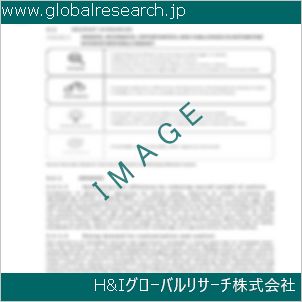1 市場概要
1.1 製品概要と範囲
1.2 市場推定の注意点と基準年
1.3 タイプ別市場分析
1.3.1 概要:グローバルな胚接着剤の消費価値(タイプ別):2020年対2024年対2031年
1.3.2 10ml/バイアル
1.3.3 20ml/バイアル
1.4 用途別市場分析
1.4.1 概要:用途別グローバル胚接着剤消費額:2020年対2024年対2031年
1.4.2 医療機関
1.4.3 研究所および研究機関
1.5 グローバル胚接着剤市場規模と予測
1.5.1 グローバル胚接着剤消費額(2020年、2024年、2031年)
1.5.2 グローバル胚接着剤販売数量(2020年~2031年)
1.5.3 グローバル胚接着剤平均価格(2020年~2031年)
2 主要メーカーのプロファイル
2.1 Vitrolife
2.1.1 Vitrolifeの詳細
2.1.2 Vitrolifeの主要事業
2.1.3 Vitrolife 胚接着剤製品とサービス
2.1.4 Vitrolife 胚接着剤の販売数量、平均価格、売上高、粗利益率、市場シェア(2020-2025)
2.1.5 Vitrolifeの最近の動向/更新
2.2 CooperSurgical
2.2.1 CooperSurgicalの概要
2.2.2 CooperSurgical 主な事業
2.2.3 CooperSurgical 胚接着剤製品およびサービス
2.2.4 CooperSurgical 胚接着剤の売上数量、平均価格、売上高、粗利益率、市場シェア(2020-2025)
2.2.5 CooperSurgicalの最近の動向/更新
2.3 Kitazato Corporation
2.3.1 Kitazato Corporationの詳細
2.3.2 Kitazato Corporation 主な事業
2.3.3 キットザトコーポレーションの胚接着剤製品およびサービス
2.3.4 Kitazato Corporation 胚接着剤の売上数量、平均価格、売上高、粗利益率、市場シェア(2020-2025)
2.3.5 北里コーポレーションの最近の動向/更新情報
2.4 AIVFO
2.4.1 AIVFOの詳細
2.4.2 AIVFOの主要事業
2.4.3 AIVFO 胚接着剤製品およびサービス
2.4.4 AIVFO 胚接着剤の売上数量、平均価格、売上高、粗利益率、市場シェア(2020-2025)
2.4.5 AIVFOの最近の動向/更新
2.5 レプロバイオテック・コーポレーション
2.5.1 Reprobiotech Corpの詳細
2.5.2 Reprobiotech Corp 主な事業
2.5.3 Reprobiotech Corp 胚接着剤製品およびサービス
2.5.4 Reprobiotech Corp 胚接着剤の販売数量、平均価格、売上高、粗利益率、市場シェア(2020-2025)
2.5.5 レプロバイオテック・コーポレーションの最近の動向/更新
3 競争環境:胚接着剤(製造業者別)
3.1 グローバル胚接着剤販売数量(製造元別)(2020-2025)
3.2 グローバル胚接着剤売上高(メーカー別)(2020-2025)
3.3 グローバル胚接着剤メーカー別平均価格(2020-2025)
3.4 市場シェア分析(2024年)
3.4.1 製造メーカー別胚接着剤の出荷量(売上高:$MM)と市場シェア(%):2024
3.4.2 2024年の胚接着剤メーカー上位3社の市場シェア
3.4.3 2024年の胚接着剤メーカー上位6社の市場シェア
3.5 胚接着剤市場:全体的な企業足跡分析
3.5.1 胚接着剤市場:地域別足跡
3.5.2 胚接着剤市場:企業製品タイプ別足跡
3.5.3 胚接着剤市場:企業製品用途別足跡
3.6 新規参入企業と市場参入障壁
3.7 合併、買収、契約、および提携
4 地域別消費分析
4.1 地域別グローバル胚接着剤市場規模
4.1.1 地域別グローバル胚接着剤販売数量(2020-2031)
4.1.2 地域別胚接着剤消費額(2020-2031年)
4.1.3 地域別グローバル胚接着剤平均価格(2020-2031)
4.2 北米の胚接着剤消費額(2020-2031)
4.3 欧州の胚接着剤消費額(2020-2031)
4.4 アジア太平洋地域における胚接着剤の消費量(2020-2031)
4.5 南米の胚接着剤消費額(2020-2031)
4.6 中東・アフリカ 胚接着剤消費量(2020-2031)
5 市場セグメント別(タイプ別)
5.1 グローバル胚接着剤販売量(種類別)(2020-2031)
5.2 グローバル胚接着剤消費量(種類別)(2020-2031)
5.3 グローバル胚接着剤の平均価格(種類別)(2020-2031)
6 市場セグメント(用途別)
6.1 用途別グローバル胚接着剤販売量(2020-2031)
6.2 グローバル胚接着剤の用途別消費額(2020-2031)
6.3 用途別グローバル胚接着剤平均価格(2020-2031)
7 北米
7.1 北米 胚接着剤の販売量(種類別)(2020-2031)
7.2 北米 胚接着剤の販売量(用途別)(2020-2031)
7.3 北米 胚接着剤市場規模(国別)
7.3.1 北米 胚接着剤の販売数量(国別)(2020-2031)
7.3.2 北米胚接着剤消費額(国別)(2020-2031)
7.3.3 アメリカ市場規模と予測(2020-2031)
7.3.4 カナダ市場規模と予測(2020-2031)
7.3.5 メキシコ市場規模と予測(2020-2031)
8 ヨーロッパ
8.1 欧州 胚接着剤の売上数量(種類別)(2020-2031)
8.2 欧州の胚接着剤販売量(用途別)(2020-2031)
8.3 欧州胚接着剤市場規模(国別)
8.3.1 ヨーロッパの胚接着剤販売量(国別)(2020-2031)
8.3.2 欧州胚接着剤の消費額(国別)(2020-2031)
8.3.3 ドイツ市場規模と予測(2020-2031)
8.3.4 フランス市場規模と予測(2020-2031)
8.3.5 イギリス市場規模と予測(2020-2031)
8.3.6 ロシア市場規模と予測(2020-2031)
8.3.7 イタリア市場規模と予測(2020-2031)
9 アジア太平洋
9.1 アジア太平洋地域 胚接着剤の販売量(種類別)(2020-2031)
9.2 アジア太平洋地域における胚接着剤の販売量(用途別)(2020-2031)
9.3 アジア太平洋地域における胚接着剤市場規模(地域別)
9.3.1 アジア太平洋地域における胚接着剤の販売量(地域別)(2020-2031)
9.3.2 アジア太平洋地域における胚接着剤の消費額(地域別)(2020-2031)
9.3.3 中国市場規模と予測(2020-2031)
9.3.4 日本市場規模と予測(2020-2031)
9.3.5 韓国市場規模と予測(2020-2031)
9.3.6 インド市場規模と予測(2020-2031)
9.3.7 東南アジア市場規模と予測(2020-2031)
9.3.8 オーストラリア市場規模と予測(2020-2031)
10 南米
10.1 南米の胚接着剤販売量(種類別)(2020-2031)
10.2 南米 胚接着剤の販売量(用途別)(2020-2031)
10.3 南米胚接着剤市場規模(国別)
10.3.1 南米の胚接着剤販売量(国別)(2020-2031)
10.3.2 南米の胚接着剤消費額(国別)(2020-2031)
10.3.3 ブラジル市場規模と予測(2020-2031)
10.3.4 アルゼンチン市場規模と予測(2020-2031)
11 中東・アフリカ
11.1 中東・アフリカ 胚接着剤の販売量(種類別)(2020-2031)
11.2 中東・アフリカ地域における胚接着剤の販売量(用途別)(2020-2031年)
11.3 中東・アフリカ 胚接着剤市場規模(国別)
11.3.1 中東・アフリカ地域における胚接着剤の販売量(国別)(2020-2031)
11.3.2 中東・アフリカ 胚用接着剤の消費額(国別)(2020-2031)
11.3.3 トルコ市場規模と予測(2020-2031)
11.3.4 エジプト市場規模と予測(2020-2031)
11.3.5 サウジアラビア市場規模と予測(2020-2031)
11.3.6 南アフリカ市場規模と予測(2020-2031)
12 市場動向
12.1 胚接着剤市場ドライバー
12.2 胚接着剤市場を制約する要因
12.3 胚接着剤市場の動向分析
12.4 ポーターの5つの力分析
12.4.1 新規参入の脅威
12.4.2 供給者の交渉力
12.4.3 購入者の交渉力
12.4.4 代替品の脅威
12.4.5 競争の激化
13 原材料と産業チェーン
13.1 胚接着剤の原材料と主要メーカー
13.2 胚接着剤の製造コストの割合
13.3 胚接着剤の製造プロセス
13.4 産業バリューチェーン分析
14 流通チャネル別出荷量
14.1 販売チャネル
14.1.1 直接エンドユーザー向け
14.1.2 卸売業者
14.2 胚接着剤の典型的な卸売業者
14.3 胚接着剤の典型的な顧客
15 研究結果と結論
16 付録
16.1 方法論
16.2 研究プロセスとデータソース
16.3 免責事項
1.1 Product Overview and Scope
1.2 Market Estimation Caveats and Base Year
1.3 Market Analysis by Type
1.3.1 Overview: Global Embryo Glue Consumption Value by Type: 2020 Versus 2024 Versus 2031
1.3.2 10ml/Vial
1.3.3 20ml/Vial
1.4 Market Analysis by Application
1.4.1 Overview: Global Embryo Glue Consumption Value by Application: 2020 Versus 2024 Versus 2031
1.4.2 Medical Institutions
1.4.3 Laboratories & Research Institutions
1.5 Global Embryo Glue Market Size & Forecast
1.5.1 Global Embryo Glue Consumption Value (2020 & 2024 & 2031)
1.5.2 Global Embryo Glue Sales Quantity (2020-2031)
1.5.3 Global Embryo Glue Average Price (2020-2031)
2 Manufacturers Profiles
2.1 Vitrolife
2.1.1 Vitrolife Details
2.1.2 Vitrolife Major Business
2.1.3 Vitrolife Embryo Glue Product and Services
2.1.4 Vitrolife Embryo Glue Sales Quantity, Average Price, Revenue, Gross Margin and Market Share (2020-2025)
2.1.5 Vitrolife Recent Developments/Updates
2.2 CooperSurgical
2.2.1 CooperSurgical Details
2.2.2 CooperSurgical Major Business
2.2.3 CooperSurgical Embryo Glue Product and Services
2.2.4 CooperSurgical Embryo Glue Sales Quantity, Average Price, Revenue, Gross Margin and Market Share (2020-2025)
2.2.5 CooperSurgical Recent Developments/Updates
2.3 Kitazato Corporation
2.3.1 Kitazato Corporation Details
2.3.2 Kitazato Corporation Major Business
2.3.3 Kitazato Corporation Embryo Glue Product and Services
2.3.4 Kitazato Corporation Embryo Glue Sales Quantity, Average Price, Revenue, Gross Margin and Market Share (2020-2025)
2.3.5 Kitazato Corporation Recent Developments/Updates
2.4 AIVFO
2.4.1 AIVFO Details
2.4.2 AIVFO Major Business
2.4.3 AIVFO Embryo Glue Product and Services
2.4.4 AIVFO Embryo Glue Sales Quantity, Average Price, Revenue, Gross Margin and Market Share (2020-2025)
2.4.5 AIVFO Recent Developments/Updates
2.5 Reprobiotech Corp
2.5.1 Reprobiotech Corp Details
2.5.2 Reprobiotech Corp Major Business
2.5.3 Reprobiotech Corp Embryo Glue Product and Services
2.5.4 Reprobiotech Corp Embryo Glue Sales Quantity, Average Price, Revenue, Gross Margin and Market Share (2020-2025)
2.5.5 Reprobiotech Corp Recent Developments/Updates
3 Competitive Environment: Embryo Glue by Manufacturer
3.1 Global Embryo Glue Sales Quantity by Manufacturer (2020-2025)
3.2 Global Embryo Glue Revenue by Manufacturer (2020-2025)
3.3 Global Embryo Glue Average Price by Manufacturer (2020-2025)
3.4 Market Share Analysis (2024)
3.4.1 Producer Shipments of Embryo Glue by Manufacturer Revenue ($MM) and Market Share (%): 2024
3.4.2 Top 3 Embryo Glue Manufacturer Market Share in 2024
3.4.3 Top 6 Embryo Glue Manufacturer Market Share in 2024
3.5 Embryo Glue Market: Overall Company Footprint Analysis
3.5.1 Embryo Glue Market: Region Footprint
3.5.2 Embryo Glue Market: Company Product Type Footprint
3.5.3 Embryo Glue Market: Company Product Application Footprint
3.6 New Market Entrants and Barriers to Market Entry
3.7 Mergers, Acquisition, Agreements, and Collaborations
4 Consumption Analysis by Region
4.1 Global Embryo Glue Market Size by Region
4.1.1 Global Embryo Glue Sales Quantity by Region (2020-2031)
4.1.2 Global Embryo Glue Consumption Value by Region (2020-2031)
4.1.3 Global Embryo Glue Average Price by Region (2020-2031)
4.2 North America Embryo Glue Consumption Value (2020-2031)
4.3 Europe Embryo Glue Consumption Value (2020-2031)
4.4 Asia-Pacific Embryo Glue Consumption Value (2020-2031)
4.5 South America Embryo Glue Consumption Value (2020-2031)
4.6 Middle East & Africa Embryo Glue Consumption Value (2020-2031)
5 Market Segment by Type
5.1 Global Embryo Glue Sales Quantity by Type (2020-2031)
5.2 Global Embryo Glue Consumption Value by Type (2020-2031)
5.3 Global Embryo Glue Average Price by Type (2020-2031)
6 Market Segment by Application
6.1 Global Embryo Glue Sales Quantity by Application (2020-2031)
6.2 Global Embryo Glue Consumption Value by Application (2020-2031)
6.3 Global Embryo Glue Average Price by Application (2020-2031)
7 North America
7.1 North America Embryo Glue Sales Quantity by Type (2020-2031)
7.2 North America Embryo Glue Sales Quantity by Application (2020-2031)
7.3 North America Embryo Glue Market Size by Country
7.3.1 North America Embryo Glue Sales Quantity by Country (2020-2031)
7.3.2 North America Embryo Glue Consumption Value by Country (2020-2031)
7.3.3 United States Market Size and Forecast (2020-2031)
7.3.4 Canada Market Size and Forecast (2020-2031)
7.3.5 Mexico Market Size and Forecast (2020-2031)
8 Europe
8.1 Europe Embryo Glue Sales Quantity by Type (2020-2031)
8.2 Europe Embryo Glue Sales Quantity by Application (2020-2031)
8.3 Europe Embryo Glue Market Size by Country
8.3.1 Europe Embryo Glue Sales Quantity by Country (2020-2031)
8.3.2 Europe Embryo Glue Consumption Value by Country (2020-2031)
8.3.3 Germany Market Size and Forecast (2020-2031)
8.3.4 France Market Size and Forecast (2020-2031)
8.3.5 United Kingdom Market Size and Forecast (2020-2031)
8.3.6 Russia Market Size and Forecast (2020-2031)
8.3.7 Italy Market Size and Forecast (2020-2031)
9 Asia-Pacific
9.1 Asia-Pacific Embryo Glue Sales Quantity by Type (2020-2031)
9.2 Asia-Pacific Embryo Glue Sales Quantity by Application (2020-2031)
9.3 Asia-Pacific Embryo Glue Market Size by Region
9.3.1 Asia-Pacific Embryo Glue Sales Quantity by Region (2020-2031)
9.3.2 Asia-Pacific Embryo Glue Consumption Value by Region (2020-2031)
9.3.3 China Market Size and Forecast (2020-2031)
9.3.4 Japan Market Size and Forecast (2020-2031)
9.3.5 South Korea Market Size and Forecast (2020-2031)
9.3.6 India Market Size and Forecast (2020-2031)
9.3.7 Southeast Asia Market Size and Forecast (2020-2031)
9.3.8 Australia Market Size and Forecast (2020-2031)
10 South America
10.1 South America Embryo Glue Sales Quantity by Type (2020-2031)
10.2 South America Embryo Glue Sales Quantity by Application (2020-2031)
10.3 South America Embryo Glue Market Size by Country
10.3.1 South America Embryo Glue Sales Quantity by Country (2020-2031)
10.3.2 South America Embryo Glue Consumption Value by Country (2020-2031)
10.3.3 Brazil Market Size and Forecast (2020-2031)
10.3.4 Argentina Market Size and Forecast (2020-2031)
11 Middle East & Africa
11.1 Middle East & Africa Embryo Glue Sales Quantity by Type (2020-2031)
11.2 Middle East & Africa Embryo Glue Sales Quantity by Application (2020-2031)
11.3 Middle East & Africa Embryo Glue Market Size by Country
11.3.1 Middle East & Africa Embryo Glue Sales Quantity by Country (2020-2031)
11.3.2 Middle East & Africa Embryo Glue Consumption Value by Country (2020-2031)
11.3.3 Turkey Market Size and Forecast (2020-2031)
11.3.4 Egypt Market Size and Forecast (2020-2031)
11.3.5 Saudi Arabia Market Size and Forecast (2020-2031)
11.3.6 South Africa Market Size and Forecast (2020-2031)
12 Market Dynamics
12.1 Embryo Glue Market Drivers
12.2 Embryo Glue Market Restraints
12.3 Embryo Glue Trends Analysis
12.4 Porters Five Forces Analysis
12.4.1 Threat of New Entrants
12.4.2 Bargaining Power of Suppliers
12.4.3 Bargaining Power of Buyers
12.4.4 Threat of Substitutes
12.4.5 Competitive Rivalry
13 Raw Material and Industry Chain
13.1 Raw Material of Embryo Glue and Key Manufacturers
13.2 Manufacturing Costs Percentage of Embryo Glue
13.3 Embryo Glue Production Process
13.4 Industry Value Chain Analysis
14 Shipments by Distribution Channel
14.1 Sales Channel
14.1.1 Direct to End-User
14.1.2 Distributors
14.2 Embryo Glue Typical Distributors
14.3 Embryo Glue Typical Customers
15 Research Findings and Conclusion
16 Appendix
16.1 Methodology
16.2 Research Process and Data Source
16.3 Disclaimer
| ※参考情報 胚接着剤(Embryo Glue)は、体外受精(IVF)やその他の生殖補助技術(ART)において、胚と子宮内膜の接着を促進するために使用される特殊な材料です。この接着剤は、胚が母体の子宮内に着床する可能性を高めることを目的としています。胚接着剤は主に胚移植の際に用いられ、最終的には妊娠率の向上に寄与するとされています。 胚接着剤の概念は、科学的な研究と技術の進歩によって進化してきました。胚の着床は、妊娠において極めて重要なステップであり、様々な要因がその成功に影響を与えます。子宮内膜の健康状態、ホルモン環境、さらには胚の質などが密接に関与しています。胚接着剤は、これらの要因を補完する役割を果たし、胚が適切に子宮内膜に接着し、発育を始める手助けをします。 胚接着剤の特徴として、まず第一にその成分が挙げられます。これらの接着剤は、一般的にヒト由来の生理的な成分や、体内で安全に分解される生体材料から成ります。これによって、免疫反応や他の副作用が最小限に抑えられます。また、胚接着剤はその粘性や浸透性によって、胚と子宮内膜の相互作用を向上させることが求められます。さらに、これらの接着剤は、特定のタイミングで使用することにより、胚移植後の着床率を高めることができます。 次に、胚接着剤の種類について考えます。胚接着剤にはいくつかの異なるタイプが存在し、使用する目的や環境によって選択されます。その一つは、ヒアルロン酸を基にした接着剤です。ヒアルロン酸は、体内に自然に存在する多糖類であり、水分保持能力に優れているため、接着剤として利用されることが多いです。ヒアルロン酸系の接着剤は、胚の保護や、子宮内膜との適切な接着をサポートします。 また、ペプチドや蛋白質を基にした接着剤も存在します。これらは特定の生理学的な活性を持ち、胚の着床を促進するために設計されています。さらに、最近ではナノテクノロジーを応用した新しいタイプの接着剤も研究されています。これにより、より効果的な胚の接着と、持続的な効果を得ることが期待されています。 胚接着剤の用途は、主に不妊治療に関連しています。体外受精の場合、胚移植は成功率が低い場合があるため、胚接着剤を用いることでその成功率を向上させることが目的となります。これにより、より多くの女性が妊娠の機会を得ることができるようになり、不妊治療の選択肢を広げることが可能となります。 また、胚接着剤は、胚の発育環境を改善するための役割も果たします。接着剤を使用することで、胚が子宮内でより適切に配置され、栄養供給や酸素供給の効率が向上することが期待されます。さらに、これにより胚が持つ成長の可能性を最大限に引き出すことができるのです。 関連技術としては、胚接着剤を使用することによる遺伝子検査技術や、胚の質評価技術が挙げられます。例えば、胚の遺伝子異常を特定するためのプレインプランテーション遺伝子診断(PGD)と併用することで、より健康的な胚を選択し、妊娠の成功率を向上させることが可能です。また、胚の成長を観察するためのタイムラプスイメージング技術も、胚接着剤と組み合わせられることがあります。この技術により、胚の動態をリアルタイムで監視し、最適な時期に胚を移植することができるようになります。 胚接着剤の開発や使用に関する研究は、現在も活発に行われています。新しい成分や技術が日々進化しており、将来的にはさらなる効果が期待されています。特に、個々の患者のニーズに応じたカスタマイズされた接着剤の開発が進むことにより、不妊治療の成功率が向上することが目指されています。 胚接着剤は、不妊治療の最前線で重要な役割を果たしており、その効果や使用方法についてのongoing researchは今後も続くでしょう。科学の進歩とともに、より多くの女性が希望を持てる未来が築かれることを期待しています。胚接着剤は、妊娠への道を拓く一助として、医療現場でますます重要さを増していくと考えられます。 |
❖ 免責事項 ❖
http://www.globalresearch.jp/disclaimer












